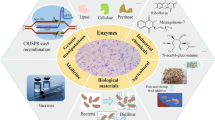Abstract
The mechanisms of action of AN5-1 against Gram-negative and Gram-positive bacteria were investigated by evaluations of the intracellular content leakage and by microscopic observations of the treated cells. Escherichia coli and Staphylococcus aureus were used for this investigation. Measurements of DNA, RNA, proteins, and β-galactosidase were taken, and the results showed a significant increase in the cultivation media after treatment with AN5-1 compared with the untreated cells. The morphological changes of treated cells were shown using transmission electron microscopy (TEM) and atomic force microscopy (AFM). The observations showed that AN5-1 acts against E. coli and against S. aureus in similar ways, by targeting the cell wall, causing disruptions; at a high concentration (80 AU/ml), these disruptions led to cell lysis. The 3D AFM imaging system showed that at a low concentration of 20 AU/ml, the effect of AN5-1 is restricted to pore formation only. Moreover, a separation between the cell wall and the cytoplasm was observed when Gram-negative bacteria were treated with a low concentration (20 AU/ml) of AN5-1





Similar content being viewed by others
Abbreviations
- TEM:
-
Transmission electron microscopy
- AFM:
-
Atomic force microscopy
- AU:
-
Arbitrary units
References
Izadpanah, A., & Gallo, R. (2005). Journal of the American Academy of Dermatology, 52, 381–390. quiz 391.
Papagianni, M. (2003). Biotechnology Advances, 21, 465–499.
Hassan, M., Kjos, M., Nes, I., Diep, D., & Lotfipour, F. (2012). Journal of Applied Microbiology, 113, 723–736.
Jack, R., Tagg, J., & Ray, B. (1995). Microbiological Reviews, 59, 171–200.
Brogden, A. (2005). Nature Reviews Microbiology, 3, 238–250.
Mannis, M. (2002). Transactions of the American Ophthalmological Society, 100, 243–271.
Silva, C., Sarmento, B., & Pintado, M. (2013). International Journal of Antimicrobial Agents, 41, 5–10.
Straus, S., & Hancock, R. (2006). Biochimica et Biophysica Acta, 1758, 1215–1223.
Teixeira, V., Feio, M., & Bastos, M. (2012). Progress in Lipid Research, 51, 149–177.
Martin, I. (2003). Journal of Biological Chemistry, 278, 13124–13132.
Todorov, S., & Dicks, L. (2006). Biotechnology Journal, 1, 405–409.
Knoetze, H., Todorov, S., & Dicks, L. (2008). International Journal of Antimicrobial Agents, 31, 228–228.
Todorov, S., Powell, J., Meincken, M., Witthuhn, R., & Dicks, L. (2007). International Journal of Dairy Technology, 60, 221–227.
Alkotaini, B., Anuar, N., Kadhum, H., & Sani, A. (2013). Journal of Industrial Microbiology and Biotechnology, 40, 571–579.
Li, A., Lee, P., Ho, B., Ding, J., & Lim, C. (2007). Biochimica et Biophysica Acta, 1768, 411–418.
Anderson, R., Haverkamp, R., & Yu, P. (2004). FEMS Microbiology Letters, 240, 105–110.
Lazarev, V., & Govorun, V. (2010). Applied Biochemistry and Microbiology, 46, 803–814.
Miyazaki, Y., Aoki, M., Yano, Y., & Matsuzaki, K. (2012). Biochemistry, 51, 10229–10235.
Li, A., Lee, P., Ho, B., Ding, J., & Lim, C. (2007). Biochimica et Biophysica Acta - Biomembranes, 1768, 411–418.
Hancock, R. (2005). Lancet Infectious Diseases, 5, 209–218.
Devine, D., & Hancock, R. (2002). Current Pharmaceutical Design, 8, 703–714.
Gee, M., Burton, M., Grevis-James, A., Hossain, M., McArthur, S., & Palombo, E. (2013). Scientific Reports, 3, 1557.
Acknowledgments
This study was supported by Research Grants UKM-DPP-2013-044 and GUP-2012-002 from the Universiti Kebangsaan Malaysia, Selangor, Malaysia.
Author information
Authors and Affiliations
Corresponding author
Rights and permissions
About this article
Cite this article
Alkotaini, B., Anuar, N. & Kadhum, A.A.H. Evaluation of Morphological Changes of Staphylococcus aureus and Escherichia coli Induced with the Antimicrobial Peptide AN5-1. Appl Biochem Biotechnol 175, 1868–1878 (2015). https://doi.org/10.1007/s12010-014-1410-4
Received:
Accepted:
Published:
Issue Date:
DOI: https://doi.org/10.1007/s12010-014-1410-4




